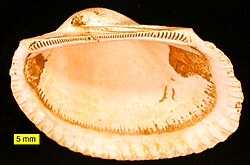| Ark clam | |
|---|---|
 | |
| Shell specimens of Anadara antiquata | |
| Scientific classification | |
| Domain: | Eukaryota |
| Kingdom: | Animalia |
| Phylum: | Mollusca |
| Class: | Bivalvia |
| Order: | Arcida |
| Superfamily: | Arcoidea |
| Family: | Arcidae Lamarck, 1809 |
| Genera | |
See text | |
Ark clam is the common name for a family of small to large-sized saltwater clams or marine bivalve molluscs in the family Arcidae. Generally less than 80 mm long, ark clams vary both in shape and size. They number about 200 species worldwide. [1]
Contents
The group is known as "ark shells" because species such as Arca have a large flat area between the umbones which, in an undamaged shell, somewhat resembles a deck, with the rest of the shell perhaps illustrating an ancient wooden boat such as Noah's Ark is thought to have been.
The thick, ridged shells of ark clams are often white, cream or tan, [1] but in some species, the shell is striped with, tinted with, or completely colored, a rich brown. In life the shell of most species has a top shell layer that is thick brown periostracum affixed to the harder calcareous part of the shell. In some species such as Barbatia , this outer horny covering is tufted at the end of the shell into something that resembles a beard, hence the name Barbatia or bearded one. The thick outer skin or periostracum of an ark clam can act as camouflage, such that the shells can sometimes look like stones when lying on the bottom.

All ark shells have a long straight hinge line with a single row of numerous small and unspecialized "teeth". This is known as a "taxodont dentition" and represents an ancient ancestor. This kind of hinge line is also found in the bivalve families Glycymerididae, Nuculidae and Nuculanidae.
Ark clams are distinct from other clams in having red blood pigments (hemoglobin) that facilitate the transport of oxygen to their tissues and enable them to inhabit more hypoxic environments. [1]
Ark clams reach reproductive maturity when they are about twelve months old and about 20 mm long. The spawning cycle typically begins in the rainy season. Ark Clams are broadcast spawners, that is, eggs and sperm are released into open water where fertilization occurs. The fertilized eggs develop rapidly into planktonic larvae that drift with ocean currents for eight to ten days during which 99.9% of the larvae are consumed or perish. Eventually the survivors settle to suitable sites of the sea floor where they develop into juvenile clams. Only one percent of these juveniles will survive to become a mature adult. Ark Clams have a maximum life span of about six years. [1]


